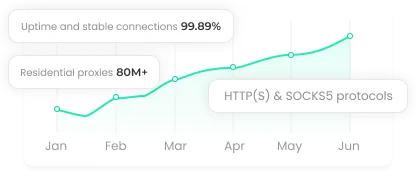How Error 520 Disrupts Workflows and Ways to Solve It

You're cruising the web, running a script, or scraping data when suddenly you hit Error 520. There's no warning, no explanation, just a wall in your workflow. It's frustrating and even more confusing. Understanding this elusive error can save you hours or even days of headaches.
The Overview of Error Code 520
Every time your browser or script talks to a server, they exchange a precise set of HTTP messages. When the origin server responds in a way that Cloudflare can't interpret, you get a 520 error.
Think of it as the server shrugging at Cloudflare: "I have no idea what you're asking." The official label? "Web server is returning an unknown error." Catchy, right? But vague. And uniquely Cloudflare. You won't find this code in the official IANA HTTP status list.
It's a catch-all. Empty responses, malformed headers, or unexpected behavior all fall under 520. Other familiar 5xx errors—like 500, 502, or 504—cover some scenarios, but 520 is Cloudflare's special way of saying, "Something went wrong, and I can't tell you exactly what."
It's also worth distinguishing similar Cloudflare codes:
521: Connection failed.
524: Origin server timed out.
520: Origin server responded, but something was off.
Why Does Error 520 Happen
The root cause? Usually the origin server itself. Common triggers include:
Crashed or misconfigured server.
Firewall or security settings blocking Cloudflare IPs.
Excessively large request headers or cookies.
Malformed or empty responses.
Incorrect HTTP/2 configuration.
Short TCP timeouts causing Cloudflare to assume an empty response.
From a visitor's view, it's all the same: the dreaded 520 screen. Yet, oddly, other pages or functions might work fine, while logging in or performing specific actions triggers it.
Quick Fixes You Can Try
While many 520 errors require server access to fix, you can attempt these first:
Retry the connection. Refresh your browser or add automatic retries in your scripts. Sometimes the server just needs a moment.
Clear cookies. Oversized headers can trigger a 520. Incognito mode or programmatic cookie handling in automation can help.
Avoid blacklisted IPs. Using proxies? Rotate IPs, change browser fingerprints, and disable conflicting tools.
If these fail, deeper fixes require server-side adjustments:
Temporarily set Cloudflare DNS records to ‘DNS only' to access the server directly.
Check server logs for crashes or anomalies.
Whitelist all Cloudflare IPs in firewall and security rules.
Ensure HTTP/2 is correctly configured.
Reduce oversized headers to within Cloudflare limits.
When all else fails, contacting your hosting provider with detailed logs, IPs, and Cloudflare Ray IDs is the next step.
How to Stop Future 520 Errors in Automation
While you can't fully prevent 520s—they're mostly server-side—you can mitigate their impact in web scraping or automation:
import time
import requests
urls = ['https://example.com/page1', 'https://example.com/page2']
max_retries = 3
retry_delay = 10
rate_limit_delay = 5
for url in urls:
success = False
for attempt in range(max_retries):
try:
response = requests.get(url)
print(f"{url}: {response.status_code}")
if 200 <= response.status_code < 300:
success = True
break
else:
print(f"HTTP error {response.status_code} for {url}")
except requests.RequestException as e:
print(f"Attempt {attempt+1} failed: {e}")
if attempt < max_retries - 1:
print(f"Retrying in {retry_delay} seconds...")
time.sleep(retry_delay)
if not success:
print(f"All retries failed for {url}")
time.sleep(rate_limit_delay)
Other tips for administrators:
Keep server software updated.
Monitor resource usage and firewall rules.
Manage headers and cookies to stay within limits.
Increase timeout values to prevent premature disconnections.
Conclusion
Error 520 is frustrating because it's vague, unpredictable, and often outside your control. For users, understanding the error and applying basic troubleshooting—retrying, clearing cookies, or rotating IPs—can solve many issues. For server admins, regular maintenance, proper configuration, and proactive monitoring are the keys to preventing it from disrupting workflows.





















































